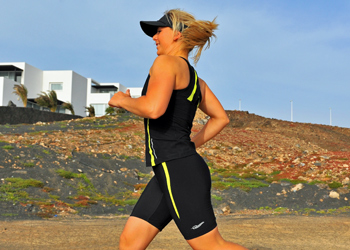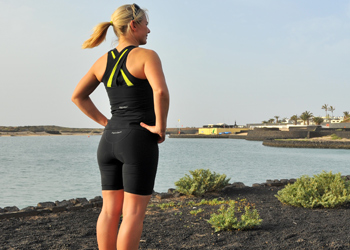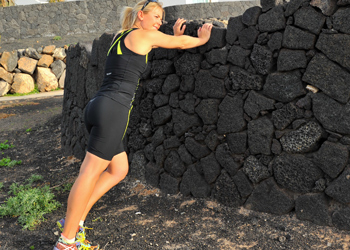Tips from the Top – Your Perfect Running Form
Looking for top tips to perfect your running form? Let’s take it from the top – your head, that is – and work our way down, helping you to achieve your perfect running form.
Your Head
 To help the rest of your body achieve perfect running form, you need to start with your head. Keep it still and centred, with your eyes looking forward (not at the ground!) This will help keep your neck long and relaxed, which will have a knock-on effect throughout your whole body. Keep your chin neutral, neither gutting out or tucked too far in toward your neck.
To help the rest of your body achieve perfect running form, you need to start with your head. Keep it still and centred, with your eyes looking forward (not at the ground!) This will help keep your neck long and relaxed, which will have a knock-on effect throughout your whole body. Keep your chin neutral, neither gutting out or tucked too far in toward your neck.
If you’re finding tension building up in your face (usually visible in a frown or grimace!), try a smile. Even if you don’t feel much like smiling, it will help to relax your facial muscles and actually may even affect your running mood!
Your Shoulders
Shoulders should be relaxed (you’ll hear that word a lot in this article!) They should be level and twist side to side slightly, but not so much that your hands cross over your centre point in the front of your body. Shoulders should directly above hips, or slightly forward (see chest/ torso).
Your Torso
For your perfect running form, you should be upright, either straight or with a slight forward lean, being sure not to bend at the waist. A good way to visualise it to think of a golden string pulling your head/spine lightly upwards, pulling out of the hips.
Again, no holding tension in your spine; light and relaxed!
Your Arms
 It’s easy to allow unnecessary tension creep into your arms – don’t! Keep them held at a 90-degree angle with a natural swing. Don’t let your hands go beyond your hips when swinging backward or higher than your shoulders when swinging forward. Instead of thinking about driving forward with your arms, which may lead to a punching-style swing, think about driving them backward.
It’s easy to allow unnecessary tension creep into your arms – don’t! Keep them held at a 90-degree angle with a natural swing. Don’t let your hands go beyond your hips when swinging backward or higher than your shoulders when swinging forward. Instead of thinking about driving forward with your arms, which may lead to a punching-style swing, think about driving them backward.
If you’re relaxed, gravity will naturally bring them forward again. If you feel tension creeping in, drop your shoulders, shake out your hands and breathe.
It should go without being said, but be certain that your legs and arms are working in op-position (opposite arm/opposite leg)!
Your Hands
Hands should be – not surprisingly – relaxed in a light fist. The best analogy is to think of holding something precious (some examples are baby chicks if you’re an animal-lover, or crisps if you prefer junk food!). You want to hold tight enough not to drop your chick/crisp, but lightly enough not to crush it.
Your Hips
Your hips should follow the lead of your torso. Don’t roll hips under, but keep them neutral, pointing straight ahead and parallel to the ground. As hip position is what can make or break your perfect run form, it’s important both to really understand your hip position and to make sure that your hips and glutes (bum muscles) are strong and firing properly. For tests to find out (and exercises to strengthen your gluten), check out this article from Runner’s World.
Your Legs
Most new runners run with a longer stride and slower cadence (how many steps you take per minute) than is optimal. Instead of going for high knees and a bouncy step, think of driving your leg forward, using a shorter stride and faster feet.
Your Feet
 Where should you land on your foot? Is your forefoot faster? Should you land on your heel? Your own biomechanics determine to some extent how you will land.
Where should you land on your foot? Is your forefoot faster? Should you land on your heel? Your own biomechanics determine to some extent how you will land.
The only real “wrong” way is to brake with your heel, typically caused by overstriding, which means that your foot and lower leg come farther forward than your hips, resulting in a heel-strike in front of your body. This not only slows you down, but can cause injury, due to harder impact. Running tall with a shorter stride and a quicker cadence will help to avoid braking.